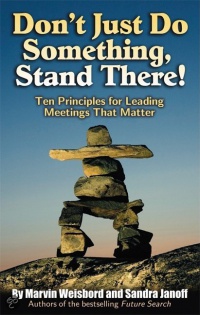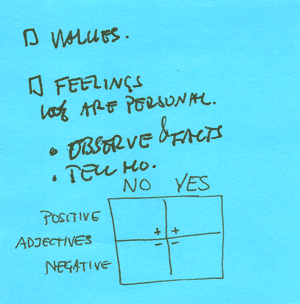Don’t just do something, stand there!
…groups, large and small, searching for future states they want to evolve to.
✣ ✣ ✣
You want to change the world one meeting at a time. Reaching shared goals in an effective and efficient way leads to the right decisions and make people energized and happy and makes a ‘yes’ really mean something.
No wonder people everywhere are so cynical about another meeting, having attended so many they considered poorly led, counter-productive, and time-wasting. The purpose of Don't Just Do Something, Stand There! is to outline the ten principles for structuring and managing meetings. Whether it is a meeting in your community, in a board rooms, with work teams, in offices, schools, factories, or hospitals, Don't Just Do Something, Stand There! shows you how to start leading meetings the right way.
Don't Just Do Something, Stand There! is organized into two major sections:
- Facilitate, or “Leading Meetings” with six principles on how to successfully structure and manage meetings; and
- Change, or “Managing Yourself” with four principles that show the keys to managing yourself—illustrating techniques to deal with anxiety, getting used to projections, establishing dependability, and learning to say no.
All principles strengthen, help each other. They are a fabric for meetings that matter. For example, if you want to explore the whole elephant, you must have the whole system in the room. Also, people take responsibility for their own perceptions and agreements if they want to find common ground. open space is an excellent example where people take responsibility.
Don't Just Do Something, Stand There!:
- shows groups how to achieve shared goals in a timely way, manage differences without flying apart, solve problems and make tough decisions, all without inefficiently re-delegating the tasks addressed
- delves into the details of how to structure meetings to greatly increase the probability that people will accept responsibility for their own actions;
- discusses the importance of philosophical perspectives, the benefits of anxiety, and techniques for saying no to unrealistic requests;
- shows how, instead of deferring action until all defects are remedied, one can make structural changes in real time that keep groups whole, open, and task-focused; by learning to help people put forward their best selves in ambiguous situations, one can make a positive ripple in the stream of life; and
- explains and demonstrates when to act and when to just stand there, and in doing so, shows how to change the world one meeting at a time.
Therefore:
Prepare and structure gatherings thoroughly and carefully. Invite the right people. Manage yourself.
✣ ✣ ✣
✣ ✣ ✣
The larger the group, the more complete the picture everyone gets.
Meetings that Matter
Purposeful, interactive face-to-face meetings that matter, that count (resonates with Agile Manifesto).
To help people themselves to:
- cooperate regardless—or because of—their differences by discovering capabilities they did not know they had;
- manage differences without flying apart—differentiate to integrate to ease the process of discovering common ground and decision-making;
- achieve shared goals in a timely way;
- solve hard problems;
- make tough decisions;
- structure meetings to greatly increase the probability that people will share responsibility.
Participants need to:
- take self-discipline to learn;
As a facilitator:
- lift the yoke of worries about peoples attitudes, motives, hidden agendas, status, and styles.
In meetings that matter, you:
- expect to participate;
- expect to be heard;
- make a difference.
Leading gatherings where diverse people:
- solve problems;
- make decisions;
- implement plans.
Meetings that matter stop:
- wasting people's time;
- cynicism;
- apathy.
Meetings that matter:
- tolerate multiple realities;
- stay focused on goals;
- keeps the groups as a whole, open and task-focused;
- are guided by safety, hope, and friendship;
- allow people to get more done with greater satisfaction in less time
- educe people to take action and responsibility—the less the facilitators do, the more the participants take over.
Change the conditions under which people meet, and you will educe constructive, integrative, future-oriented action. Change the meeting's structure is the short-cut for people wanting to change their own behavior. Pay attention more and act less. Be quiet on the outside and active on the inside. Become visibly active at times when people want to fight or flee (or freeze) the goals, the task, the problem, or decision. In these times, you can be at your best when you can contain your own anxiety and quiet yourself inside.
Work with people as they are, not as you wish them to be. Take people as they are, there are no others.
When facilitating meetings that matter, you:
- manage structure, not behavior;
- match participants to goals;
- invite people to share responsibility;
- pay attention to time and space.
If you manage a meeting's structure, the participants will take care of the rest.
- See people doing their best with what they have rather than using labels like “restistance” and “defensiveness”.
- Build towards a comprehensive of the whole and a picture of the preferred future rather than list problems.
- Ask “What are the possibilities here, and who cares? ” rather than “What went wrong here, and how can we fix it?”
Behavior
- Do you bring few useful skills and relevant experience to the gathering?
- Are you always unprepared for gatherings?
- Do you grasp the firm’s central idea and business strategy?
- Are your questions focused and appropriate?
- Do you bring many ideas or leads on business development?
- Does gathering have established norms on what is expected of its participators?
- Has the line between leading and staying out of the way been made clear by the lead or chief?
- Have you been asked for confidential feedback on dysfunctional peers in the gathering?
- Has the lead privately coached someone into appropriate, constrictive behavior?
Notes
Pearls for Meetings that Matter
| Meetings that Matter | Goal: | Therefore: |
|---|---|---|
| 3 × 3 rule | gain a better resolution much faster while optimizing the whole | Get any three levels and any three functions into the same conversation on any issue of mutual concern. |
| Allies experience differences | set up conditions under which every person can be independent of group pressure | Identify differences, make them heard, involve everyone, create subgroups exploring and integrating the differences. |
| Are in | co-create and integral solution or decision with everyone who holds a stake in the initative | Include the right mix of authority, resources, expertise, information and those affected. |
| Clarifying go-around | find out what to do next | Nearly always start with a go-around, giving everyone a chance to suggest a next step. |
| Common ground | increase cooperation and fast action on matters of shared concern | |
| Dependable authority | be consistent, congruent, and coherent despite a salvo of projections onto you and onto others | |
| Differentiate to integrate | ease the process of discovering common ground and decision-making | Be ‘differish’ to integrate. |
| Four rooms of change | know where you are and what to do next | |
| Generative images | allure people to create openings for new, productive conversations about issues they care about | Attract people with an, often ambiguous and paradoxical, slogan that evokes an attractive, generative image to new, productive conversations, allowing many facets so people can leap into it into it in ways no one ever thought about before. |
| Images of potential | innovatively, creatively and energetically improve the whole system | Ask questions like “What is the possibility here? So what? Who cares? Who is exited about the possibilities?” |
| Integrating statement leaps forward | move on after a near complete spectrum of views is on the table | |
| Just say no | make your ‘yes’ mean something | Listen to the other's request and provide an understanding “No”, along with its motivation. Find a solution and track progress. |
| Match people to the task | fit the capability of the group to the size of the issue | Include all key actors in the dialogue. |
| Mirror, mirror on the wall | find out how you see yourself in others and adopt a couple of group practices to pair | Read out loud the three qualities of someone you find totally attractive and someone you find totally irritating. |
| People take responsibility | encourage participants to own their own meetings, outcomes, and future | |
| Projection alert | become aware of your own likes and dislikes and turn them into nutricients for personal growth | |
| Relax | control what you can and let go what you cannot | |
| Spectrum of views | develop a more grounded sense of what initial opposing consider relevant and uncover a continuum of opinions | Form subgroups that listen to each other’s conversations to discover differences that can be integrated. |
| Whole elephant | lay the groundwork for people to open up to each other | Get out all the issues, find out what matters most, and only then explore any solutions and directions to resolve one or more issues. |
| Whole system in the room | understand everyone’s stakes, faster decision-making, and greater personal responsibility | In each meeting, include all the relevant people who “ARE IN” . |
| Wind through a tree | control your response to a situation and contain your “hot buttons” | Control your response to a situation and contain your “hot buttons”. |
Sources
- Don’t just do something, stand there!—Ten Principles for Leading Meetings That Matter by Marvin Weisbord, Sandra Janoff
- Agile Retrospectives by Esther Derby and Diana Larsen
- IAF » Marvin Weisbord,Sandra Janoff » Don’t Just Do Something, Stand There: Ten Principles for Leading Meetings That Matter
- HBR » Amy Gallo » The Seven Imperatives to Keeping Meetings on Track
- HBR » Ram Charan, Dennis Carey, Michael Useem » Root Out Dysfunction in the Boardroom
- Seth’s Blog » Seth Godin » Conference call hygiene

